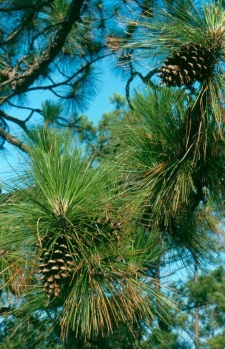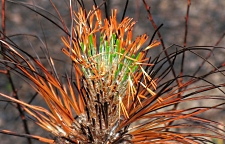Wildlife - Species
Longleaf Pine (Pinus palustris)
Description
Longleaf pine belongs to the pine family (Pinaceae). The leaves occur in bundles of five and are 25-40 cm (10 to 16 in) long. The young stems, before the leaves emerge, resemble large candles. For the first 5-7 years, the young plant looks like a tuft of coarse grass; however, when the stem does start elongating, growth is rapid, and the plant is very conspicuous, with a large clump of long leaves near the end of the stem.
Preferred Habitat and Biology
Longleaf pine occurs from Virginia south to Florida and west to Texas. Longleaf pine grows best in a humid, subtropical climate characterized by long, hot summers and mild winters. Longleaf pine grows on sandy soil with low organic content and poor to excessive drainage. In the ACE Basin, longleaf pine stands, both planted and natural, grow in moderately to poorly drained areas.
Longleaf pine populations are maintained by sexual reproduction. The trees normally do not bear seeds until they reach six inches in diameter. The development of a viable seed crop requires three growing seasons from the time of flower bud initiation. During the first year, flower buds grow during midsummer, reaching maturity during the winter. The following spring, the female flowers are fertilized by airborne pollen, and the seeds reach maturity in early October of the third growing season. The seeds are disseminated by the wind, and most of them are carried less than 120 feet away from the parent tree.
Seeds typically germinate within one week after seedfall. Germination rates of seeds are often above 90 percent, especially in recently burned areas. Fires reduce the grass cover, creating bare areas where seeds can germinate. Primary needles appear shortly after germination and secondary needles about two months later. Seedlings typically remain in a grass stage for three to seven years. During this period, diameter and height growth are slow; most plants only grow two inches tall and one inch in diameter. The next growth stage, the elongation period, is signified by rapid growth. Some seedlings are known to elongate 30 centimeters (12 inches) during the first growth spurt.
Species Significance
Many species of birds and mammals feed on seeds of the Longleaf Pine. Pine needles are also consumed by grouse and several browsers such as the white-tailed deer. Northern mammals, such as the porcupine, use the bark and wood as food. Pines are also a valuable cover for wildlife. They are favorite roosting sites for robins during migration and commonly provide nesting sites for bald eagles and other raptors.
The South Carolina Heritage Trust Program considers longleaf pine to be a species of concern. Approximately seven million acres (3%) of the estimated 97 million acres of the original longleaf pine habitat in the Southeast exists today. Efforts are underway throughout the Southeast to acquire and restore the best remaining examples of the habitat.
References
Fowells, H.A. (ed.). 1965. Silvics of forest trees of the United States. Agriculture Handbook No. 271. Division of Timber Management, Forest Service, United States Department of Agriculture, Washington, DC.
Frost, C.C. 1993. Four centuries of changing landscape patterns in the longleaf pine ecosystem. p. 17-43. In: S.M. Hermann (ed.). The Longleaf Pine ecosystem: Ecology, restoration and management. Proceedings of the Tall Timbers Fire Ecology Conference, No. 18. Tall Timbers Research Station, Tallahassee, FL.
Martin, A.C., H.S. Zim, and A.L. Nelson. 1951. American wildlife and plants: A guide to wildlife food habits. Dover Publications Inc., New York, NY.
Radford, A.E., H.E. Ahles, and C.R. Bell. 1968. Manual of the vascular flora of the Carolinas. The University of North Carolina Press, Chapel Hill, NC.


